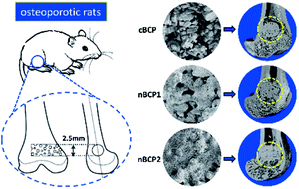Our official English website, www.x-mol.net, welcomes your
feedback! (Note: you will need to create a separate account there.)
In vitro and in vivo assessment of nanostructured porous biphasic calcium phosphate ceramics for promoting osteogenesis in an osteoporotic environment†
RSC Advances ( IF 3.9 ) Pub Date : 2018-04-18 00:00:00 , DOI: 10.1039/c8ra00768c Kun Zhang 1 , Jieyu Zhang 1 , Kelei Chen 2 , Xuefeng Hu 1 , Yunbing Wang 1 , Xiao Yang 1 , Xingdong Zhang 1 , Yujiang Fan 1
RSC Advances ( IF 3.9 ) Pub Date : 2018-04-18 00:00:00 , DOI: 10.1039/c8ra00768c Kun Zhang 1 , Jieyu Zhang 1 , Kelei Chen 2 , Xuefeng Hu 1 , Yunbing Wang 1 , Xiao Yang 1 , Xingdong Zhang 1 , Yujiang Fan 1
Affiliation

|
Treatment of bone defects in osteoporotic patients with bone substitutes is difficult, due to insufficient osseointegration. The development of appropriate biomaterials to solve the problem requires the assessment of the material performance in an osteoporotic environment, which is rarely investigated. Herein, nanostructured biphasic calcium phosphate (nBCP) ceramics were prepared via the incorporation of hydroxyapatite nanoparticles (HANPs) into porous biphasic CaP (BCP) substrates, leading to an increase of over 500% in the specific surface area. Primary osteoblasts harvested from osteoporotic rats were cultured on the nBCP ceramics, and it was found that the osteoblast functions, including proliferation, alkaline phosphatase activity, osteocalcin secretion and expression of osteogenic genes, were significantly enhanced compared with osteoblasts grown on non-nanostructured BCP ceramics. To further assess the osteoinduction ability, the ceramics were implanted in the femur of osteoporotic rats. Compared to the rats implanted with non-nanostructured BCP ceramics, a higher amount of mechanically matured bone was newly formed in the rats with nBCP ceramics after 6 weeks of implantation. Such enhanced osteoinduction ability of the nBCP ceramics may be due to the incorporated HANPs, as well as the nanostructured topography induced by the HANPs. These results indicate good in vitro and in vivo osteoinductivity of the nBCP ceramics in an osteoporotic environment and offer potential benefits for treating bone defects in osteoporotic patients.
中文翻译:

纳米结构多孔双相磷酸钙陶瓷在骨质疏松环境中促进成骨的体外和体内评估†
由于骨整合不足,用骨替代物治疗骨质疏松患者的骨缺损很困难。开发适当的生物材料来解决该问题需要评估骨质疏松环境中的材料性能,而这方面的研究很少。在此,通过将羟基磷灰石纳米颗粒(HANP)掺入多孔双相磷酸钙(BCP)基材中制备了纳米结构双相磷酸钙(nBCP)陶瓷,比表面积增加了500%以上。将骨质疏松大鼠的原代成骨细胞在nBCP陶瓷上培养,发现与非纳米结构BCP陶瓷上生长的成骨细胞相比,成骨细胞的增殖、碱性磷酸酶活性、骨钙素分泌和成骨基因表达等功能显着增强。为了进一步评估骨诱导能力,将陶瓷植入骨质疏松大鼠的股骨中。与植入非纳米结构BCP陶瓷的大鼠相比,植入nBCP陶瓷的大鼠在植入6周后新形成的机械成熟骨量更高。nBCP 陶瓷增强的骨诱导能力可能是由于掺入的 HANP 以及由 HANP 诱导的纳米结构形貌。这些结果表明nBCP 陶瓷在骨质疏松环境中具有良好的体外和体内骨诱导性,并为治疗骨质疏松患者的骨缺损提供潜在益处。
更新日期:2018-04-18
中文翻译:

纳米结构多孔双相磷酸钙陶瓷在骨质疏松环境中促进成骨的体外和体内评估†
由于骨整合不足,用骨替代物治疗骨质疏松患者的骨缺损很困难。开发适当的生物材料来解决该问题需要评估骨质疏松环境中的材料性能,而这方面的研究很少。在此,通过将羟基磷灰石纳米颗粒(HANP)掺入多孔双相磷酸钙(BCP)基材中制备了纳米结构双相磷酸钙(nBCP)陶瓷,比表面积增加了500%以上。将骨质疏松大鼠的原代成骨细胞在nBCP陶瓷上培养,发现与非纳米结构BCP陶瓷上生长的成骨细胞相比,成骨细胞的增殖、碱性磷酸酶活性、骨钙素分泌和成骨基因表达等功能显着增强。为了进一步评估骨诱导能力,将陶瓷植入骨质疏松大鼠的股骨中。与植入非纳米结构BCP陶瓷的大鼠相比,植入nBCP陶瓷的大鼠在植入6周后新形成的机械成熟骨量更高。nBCP 陶瓷增强的骨诱导能力可能是由于掺入的 HANP 以及由 HANP 诱导的纳米结构形貌。这些结果表明nBCP 陶瓷在骨质疏松环境中具有良好的体外和体内骨诱导性,并为治疗骨质疏松患者的骨缺损提供潜在益处。











































 京公网安备 11010802027423号
京公网安备 11010802027423号